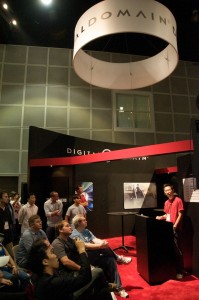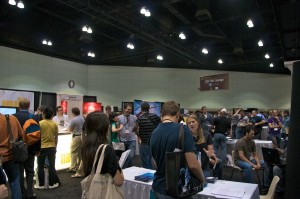We visit the job fair, catch up with Eyeon, Pixel Farm, check out some new fast hardware from Sony and Texas Memory Systems and discuss the FJORG! winning entry.
Job Fair
The Job fair was as always a very busy and important part of the show, Siggraph is a brilliant chance for attendees to sit down with potential employers. This year saw a lot of interest with the games recuriters. Inside the Job fair, Blizzard and UbiSoft seemed to always have a long line. In addition to the games companies in the Job Fair there were a lot of facilities represented including MPC, Double Negative, The Orphanage. On the show floor there were booths that included R&H, DD, Pixar, Lucasfilms, Motion Theory, and Frantic Films.
Fusion Version 6
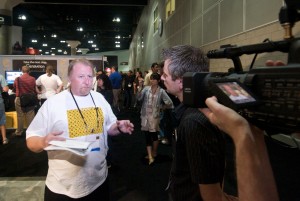
It has been a while between drinks for Eyeon, since their last major release. The new version heavily uses a GPU pipeline to speed up production. It fully supports an OpenEXR pipeline, it now adds a stereoscopic workflow, using the multi-eye OpenEXR format: SXR.
There is also a new 3D System which provides resolution independence and floating point rendering. It has super-sampling with reconstruction filters and a new plugable CG Shaders architecture. The system works with Deep Pixel rendering of Normals, Texture Co-ordinates, Material ID, Object ID, Diffuse, Specular and Shadows, etc. Allowing for relighting and advanced compositing. In addition there is a new 3D Environment Tool with Environment mapped reflections and refractions. 3D Cube and Sphere mapping.
PF Track
![]() Pixel Farm’s MD Richard Spohrer discussed with fxguide on Thursday the new release of version 5.0. This release includes stereo support. Their stereo solution is to solve for both cameras and then to use the solution from the primary eye to aid in the solution of the secondary eye. From this they can derive both the interoccular distance and the convergence. Further more Masks generated in one camera are applied to the other camera.
Pixel Farm’s MD Richard Spohrer discussed with fxguide on Thursday the new release of version 5.0. This release includes stereo support. Their stereo solution is to solve for both cameras and then to use the solution from the primary eye to aid in the solution of the secondary eye. From this they can derive both the interoccular distance and the convergence. Further more Masks generated in one camera are applied to the other camera.
As stereo produces a need for very accurate matching of tracking points the PixelFarm moved to pattern matching from point tracking. This allows for great accuracy and aid in over all improved 3D tracks.
One popular addition, especially for improving nodal pans is the addition of reference frames. These frames can be virtually any resolution and really aid in scene reconstruction.
Along with all of this there is an improved solver which provides even more accuracy on complex tracks.
Sony ZEGO
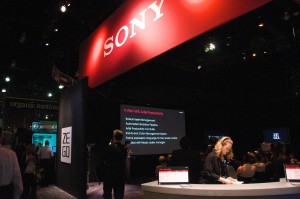 Sony unveiled a new workflow solution for faster processing of high-resolution effects and computer graphics. This new technology platform, named ZEGO™, is based on the Cell/B.E. (Cell Broadband Engine™) and RSX® technologies, and is designed to eliminate bottlenecks that can occur during post production, especially during the creation and rendering of visual effects.
Sony unveiled a new workflow solution for faster processing of high-resolution effects and computer graphics. This new technology platform, named ZEGO™, is based on the Cell/B.E. (Cell Broadband Engine™) and RSX® technologies, and is designed to eliminate bottlenecks that can occur during post production, especially during the creation and rendering of visual effects.
The Cell type architecture, known as on-chip parallelism, packages a collection of processors and co-processors in a combination that is specifically designed to optimize specific types of applications. It incorporates a low-power consumption design with the added benefit of reduced operational costs when many units are run in a clustered configuration.
Side Effects and Mental Images have been working with Sony to create applications which take advantage of the ZEGO platform.
Texas Memory Systems
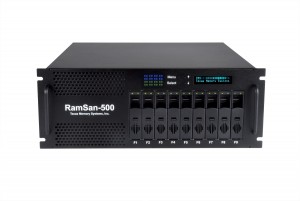
Texas Memory Systems was showing off their line of RamSan storage devices at the show, and if you find you need to saturate your Fibre Channel with data, they’ve got the product for you. They announced the flash RAID RamSan-500 at the show, which is available in one or two terabyte capacities, with 16 to 64 GB of DDR cache.
The storage system is 4 rack units and uses about 300 watts of power at its peak and uses a combination of DDR RAM and Flash Memory (NAND-SLC) and looks just like a disk to the network or operating system, so it’s compatible with any OS. You can attach it to a SAN with up to eight 4-gigabits per second Fibre Channel ports. Due to the crazy IO capabilities of the RamSan (100,000 random I/Os per second sustained), the product is popular in database and server intensive applications. But with 2 GB per second sustained bandwidth, it could make a very interesting — albeit expensive — storage solution.
FJORG! Animation Winner in The Saddest Story competition
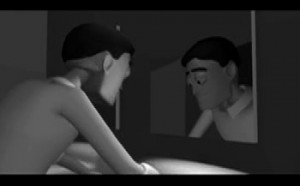 Team Grojf was chosen as the FJORG! winner for their animated reel, “The Red Truck,” comprised of Jacob Patrick, John Nguyen, and Kevin Rucker, were chosen from a field of 16, three-member teams that competed for 32 straight hours to create character-driven animations under extreme pressure and multiple staged distractions.
Team Grojf was chosen as the FJORG! winner for their animated reel, “The Red Truck,” comprised of Jacob Patrick, John Nguyen, and Kevin Rucker, were chosen from a field of 16, three-member teams that competed for 32 straight hours to create character-driven animations under extreme pressure and multiple staged distractions.
As overall winners, Team Grojf will receive an exclusive chauffeured tour through Walt Disney Animation Studios and DreamWorks Animation Studios, as well as other recognition and prizes. Adhering to this year’s required theme (The Saddest Story Ever Told), The Mexicutioners and The Fjantastic Fjorgers tied for second place, with Honorable Mentions awarded to teams Mouthful of Cookies and Trikings. These teams will also receive trophies and prizes.
All FJORG! teams were provided with limited supplies of animation hardware and software from some of todayâs top firms, music, and a series of sound bites to create their 15-second reels. FJORG! judges included Team MoCap, winners of FJORG! 2007, as well as several industry experts including:
Julien Bocabeille, Co-Director of “Oktapodi,” Best of Show Award Nominee, SIGGRAPH 2008 Computer Animation Festival
Bill Kroyer, Senior Animation Director, Rhythm & Hues
Maggie Malone, Director of Creative Development for Walt Disney Animation Studios
Dan Sarto, Co-Founder and Publisher, Animation World Network
Simon J. Smith, Director of “Bee Movie” for DreamWorks Animation Studios
Downland and view The Red Truck from FJORG! 2008

